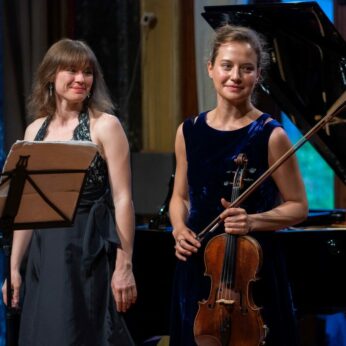Composer: Dmitri Shostakovich (b. 1906 - d. 1975)
Performance date: 02/07/2022
Venue: Bantry House
Composition Year: 1975
Duration: 00:34:30
Recording Engineer: Eduardo Prado, Ergodos
Instrumentation: va, pf
Instrumentation Category:Duo
Artists:
Dana Zemtsov -
[viola]
Anna Fedorova -
[piano]

Dmitri Shostakovich [1906-1975]
Sonata for Viola and Piano Op.147 [1975]
1. Moderato
2. Allegretto
3. Adagio
Fyodor Druzhinin was violist in the Beethoven Quartet from 1964, when he replaced his teacher Vadim Borisovsky at short notice. He took part in the premieres of six Shostakovich quartets, including the Thirteenth, dedicated to Borisovsky and featuring the viola in a prominent role. None of this however prepared him for a phone call from Shostakovich in July 1975 saying he was writing a viola sonata and seeking his advice on technical problems
Shostakovich suffered from poor health all his life, but from 1958 a combination of heart problems and a form of polio left him increasingly debilitated. However it was cancer that killed him. Right up to the last moment his phenomenal creative energy never left him. The Viola Sonata was finished in hospital on 5 July 1975, Druzhinin received the score on 6 August and Shostakovich died on 9 August. Druzhinin and Muntyan premiered the work in the composer’s home in front of an invited audience of musicians on 26 September that year, on what would have been the composer’s 69th birthday.
Shostakovich told Druzhinin his idea of the sonata. The first movement is a novella, the second a scherzo, and the Finale is an adagio in memory of Beethoven; but don’t let that inhibit you. The music is bright, bright and clear. Much of his late music was unbearably dark and pessimistic but this last masterpiece seems to have shaken off this burden of horror and despair. The viola’s mesmerising pizzicato opening creates an almost peaceful mood as piano and viola circle uneasily with brief glimpses of luminosity. The music does eventually cry out in anger and pain. After this great outburst it seems the composer is in no hurry as the ideas unfold at an almost leisurely pace though the music is far from relaxed. The rich, dark colours of the viola are wonderfully exploited and include a written-out cadenza before the coda once more re-visits the opening.
The Scherzo recycles music from Shostakovich’s abandoned opera of Gogol’s The Gamblers, a hilarious and wicked story of the stinger stung, a professional gambler and card-sharp outwitted by a group of hick gamblers. After the near fatal experience of his Lady Macbeth, that so disastrously incurred Stalin’s disapproval, Shostakovich had not dared to complete another opera. He began The Gamblers immediately after the Leningrad Symphony but realised neither performance nor publication would ever be allowed. There are layers upon layers in this extraordinary movement, which may have begun as a cheerful way of reclaiming music written 34 years earlier, but dramatically transforms itself as it approaches the end.
The finale’s opening clearly signals this will be one of his deep and searching Adagios. He goes on to quote quite unmistakably from the Moonlight Sonata, as if saying it is Beethoven you must honour, not me. This is music of unutterable beauty, haunted by the rocking rhythm of the piano. It is almost entirely devoid of passion except for the devastating central outburst. That Shostakovich knew he was writing his last work has recently been pointed out for he incorporates note-for-note quotations from his Second Violin Concerto and, in chronological order, all fifteen of his symphonies. And so the great master sings his long, long farewell before everything fades away in a halo of radiance into the silence.
Francis Humphrys
Copyright © 2024 West Cork Music. All rights reserved.
Designed and developed by Matrix Internet